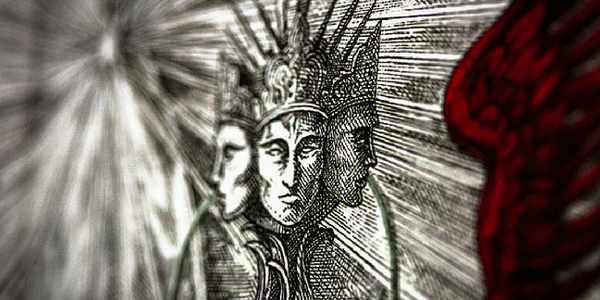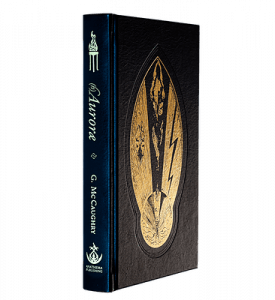
 (h)Aurorae, by Gabriel McCaughry, illustrated by Jose Gabriel Alegria Sabogal, forward by Shani Oates Anathema Publishing Ltd., 9780994911155, 304 pp. (incl. glossary and appendix), 2018
(h)Aurorae, by Gabriel McCaughry, illustrated by Jose Gabriel Alegria Sabogal, forward by Shani Oates Anathema Publishing Ltd., 9780994911155, 304 pp. (incl. glossary and appendix), 2018
(h)Aurorae by Gabriel McCaughry radiates with numinous energy. Unwrapping this book from the packaging, I could feel the solemn vibration of potent wisdom, the gnosis contained within humming. It was evident from the start that this book requires a certain care and preparation.
I hardly let myself delve into the first pages before realizing that it wasn’t the right time to plunge in. I had an intuitive feeling I wasn’t ready to open myself to what lay within the pages. The opportune time would have to call forth my psychic merge with the content of this book. Until then, I would have to wait with the patience of any seeker striving to comprehend mysteries. Instead, I decided to create an altar space for (h)Aurorae. The purpose was twofold: I wanted to bring the book into resonance with myself, as well as utilize the charge of the book for my own workings. The book alone, closed and unread, radiate with energy that lent a boost to meditations and personal spellwork undertaken in the eight weeks it took for the integration process between myself and (h)Aurorae to take place. After a quick series of turbulent life events, which I truly feel were a result of my choice to undertake the initiatory process of creating space in my life to embrace the book, (h)Aurorae became my lifeboat in the sea of spiritual abyss.
In (h)Aurorae, McCaughry has created a compilation of occult revelation, prose and imagery. Reminiscent of historical grimoires, such as The Book of Abramelin, the book is a compilation of his most cherished pieces of knowledge gain from experience, majestically laid out for the readers to decipher themselves. The book serves as a dedication to McCaughry’s pursuit to document a spiritual journey through Gnostic Luciferism, drawing on alchemical allegory as the metaphor for the process. The pages are brilliantly illustrated by Jose Gabriel Alegria Sabogal.
(h)Aurorae is divided into three books. Book one is comprised of five codices, in addition to a compelling forward by Shani Oates and an introduction by McCaughry. This first book is unique as it is filled with short poetic passages, coupled with captivating imagery. For the most part, the imagery is a stark black and red against the pale page. The bold colours are the perfect visual compliment of light and dark, adding to the depth of the passages. Here and there, an image is coded with deep blue, greens and yellows for an added effect. The words tell a story, much like that of a myth, whose meaning is not clearly stated, allowing for the imagination to do what it will with the words given.
Book two of (h)Aurorae delves into the philosophy of Gnosticism and its relation to Luciferianism. Through extending Christian Gnosticism to include Lucifer, McCaughry takes on concepts such as truth, destiny, fate and the ultimate doubt that propels us forward. A lexicon is provided that helps to clarify the system presented in the book. Terms include Lucifer, the Omni-Cipher, PCR (Prism Concrete Reality), and the Monolith. Through coming to understand the way in which these titles are being used, new doorways are opened for exploration. In this section McCaughry writes, “Magick is the humility required to acknowledge greatness within. Man’s primal desire, since time immemorial, is to dream ourselves as ‘real.’ To Will out of contemplation the ‘I’ and the ‘we.’”1
How one goes about discovering (or instigating a practice geared towards one’s hermetic potential, thereby putting the Will to work) falls to the discretion and temperament of the neophyte, as well as the experienced magus. Magick cannot be narrowed down or be defined by coloured qualifiers, as Magick in itself is not the cause behind the Mysteries. Rather, Magick bears the attributes and parameters we appoint to it, and is the residual effect of the Arte, experienced in walking the Path of Exile and Exalt.2
Book three is the story of a pilgrim along the Gnostic path. It uses alchemical terms for the process of going through the series of shifts in consciousness required to reach illumination. By leaving things behind, embracing sacrifice, walking the path of solitude, one begins the path to cultivate their philosopher’s stone. McCaughry includes a ritual he performed during his own process of working this energy. It is a rather intense ritual, which he provides in full detail to be replicated if one feels called to do so.
McCaughry gives an artistically worded description of the path of initiation. Once again, combining a sense of alchemical allegory with mythical wording, he paints a picture that in many ways conveys a poetically esoteric and philosophical representations of what it means to undertake the journey of gnosis. McCaughry writes, “Each day, one should reflect and ask of themselves if, thus far, they have yet lived a meaningful life. The answer should always come as a resounding No! This self-affirming negation (a responsible ‘echo’) is perhaps the healthiest form of self-sublimation there is, as saying so abnegates complacency.”3 In this writing, he does not sugarcoat the process, nor is the merit of it embellished.
(h)Aurorae ends with a conclusion about the Luciferian pilgrimage. The finale will leave the reader assured of the ultimate cyclic nature of the experience, never to be replicated the same way twice. There is a sense of succinct culmination, which leaves ample room for the reader to pursue their own workings and line of thought. A detailed appendix of alchemical drawings and explanations follows the conclusion. McCaughry then includes a list of all the sources he drew from in creating his work, allowing readers to go further into exploration of the material. There is a glossary providing definitions for all the occult, alchemical, and magical words used in the text. Terms such as “archons,” the rulings angels of Barbeloetic order of the Cube of Space, and “la Lumiere Senestre,” the Sinister Light, are defined in order for the reader to better grasp and comprehend the work. I found the glossary immensely helpful while reading (h)Aurorae, as it was nice to have the author provide the intended definition, and not have to spend too much time seeking the meaning in the text.
I won’t get into the specifics of what prompted my sense that it was the appropriate time to start the journey of reading (h)Aurorae, but I can say from the time of its arrival, there was a clear path that seemed to cut through my life in order to allow for the moment to unfold in a chaotic synchronicity. The book came to fulfill quite a specific purpose in my spiritual revelation, one that I know I would have not been prepared to receive only a few weeks prior. It is for this reason, I recommend it only to those who are willing to invite with due diligence the power that is contained within (h)Aurorae into their life. The workings of the book are hardly superficial, and they require the courage to step outside the spectrum of monotonous thinking. The book is dedicated to Lucifer after all.
As I read the book, it felt like layers of myself were stripped bare for evaluation. The imagery in the book was a potent catalyst for my visualization practice. Taking time to absorb the writing of McCaughry in tandem with the artwork of Jose Gabriel Alegrfa Sabogal was quite a personal experience for me.
I absolutely loved the way McCaughry drives his philosophical ramblings across the page, with poignant occult revelation sprinkled within. Bit of insight spoke to my core such as, “When one is no longer compelled to feel ‘safe,’ and walks freely and confidently, trusting in his own inner strength to go forward in defiance, not only does the false notion of fear disappear, but so does the demiurge and his nihilistic light.”4 I spent a lot of time reflecting on the words put forth in this book, which McCaughry himself invites reader to doubt, and found pleasure in dissecting the comprehensive text.
(h)Aurorae is absolutely a must have for one’s occult philosophy collection; the limited quantity of the book ensures it will fall into the right hands (500 Standard Edition hardcover books individually hand-numbered, 125 Collector’s Edition hardcover books individually hand-numbered and signed by author, 11 Artisanal Edition with handmade illustrations by José Gabriel Alegría Sabogal, signed and glyphed by McCaughry). It has the quality of a medieval grimoire, but with the application of insight relevant to the present day. For those who are able to acquire a copy, (h)Aurorae is bound to be a book one returns to over again through the year. I have no doubt each time one opens a page, a new way of comprehending the text will emerge. The layers of wisdom are sure to reveal themselves with each careful reading, particularly so with application to understanding the foundation of the text through reading the references and meditation on the linguistic choices used.








